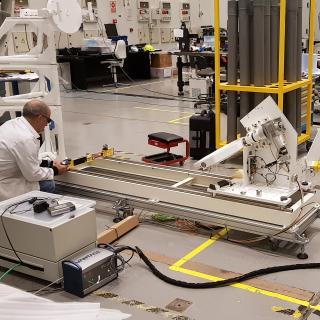The Solar Orbiter mission was selected by ESA for the M1 slot within the Cosmic Vision program with a launch date in 2018. This proposal corresponds to the period of 2017-2020 and includes the integration of the SO/PHI instrument in the platform, the launch, and the two first years of commissioning prior to the first scientific operation orbits. The flight and spare models are to be delivered to ESA by end of 2016. SO/PHI, the Polarimetric and Helioseismic Imager for Solar Orbiter, was selected by ESA as one of the remote sensing instruments aboard the spacecraft.
Its main task is the measurement of the photospheric vector magnetic fields and velocity flows of the solar photospheric plasma. It will provide the magnetic context for all the other instruments on board and also to the related NASA mission, Solar Probe Plus. The Spanish consortium that has participated in the design, development, and manufacturing of SO/PHI includes the instrument Co-Principal Investigator, which guarantees a high visibility for the contribution. The level of participation in the instrument is slightly above 40%, including responsibilities at system level. The Spanish consortium is also direct responsible of the following subsystems: Full Disk Telescope, two Polarization Modulator Packages based on Liquid Crystal Variable Retarders (a space qualified technology qualified in Spain within an ESA-led industrial activity), electronics-unit systems engineering, integration and verification, the analog control board and components including the data analysis unit (radiative transfer equation inverter), the image stabilization system electronics, the power converter module, the harness, the instrument thermal and structural design including procurement of the corresponding hardware, the instrument radiation engineering and analysis, the instrument software simulator and the transport containers and hoisting device of the optical unit.
Other smaller contributions to various subsystems and the Spanish scientific contribution to the science definition of both the mission and the instrument are also included. The Spanish contribution of the various institutes is coordinated by the IAA-CSIC. This coordinating institute acts as a point of contact with the PI project office at the MPS in Göttingen (Germany).
SO/PHI largely benefits from a very strong heritage from the IMaX/Sunrise instrument built by this Spanish consortium and flown successfully in 2009 and 2013. Such a Spanish contribution to the Sunrise mission has been strongly supported by the consecutive phases of the National Plan since 2003 and has built both a scientific and a technological milestone. The two first flights success has motivated the preparation of a third one where, to the former German, American, and Spanish associates, Japanese colleagues have joined the team for a fully worldwide scientific adventure. Besides of a completely renewed IMaX, the Spanish consortium has been invited to provide the electronics and software of the spectropolarimeter, SP. The optics of this instrument is provided by the Japanese and the cameras by the Germans. This new technological contribution increases the Spanish solar physics visibility an guarantees a high scientif return.



